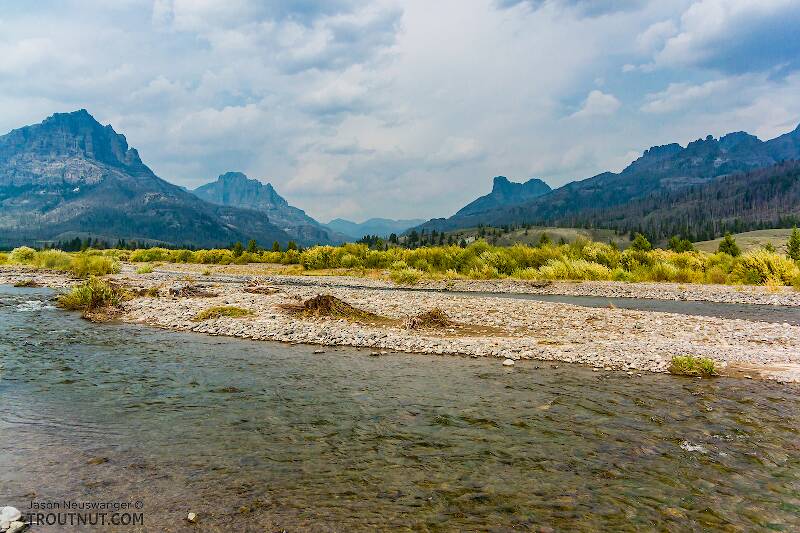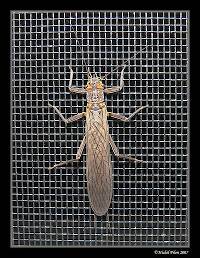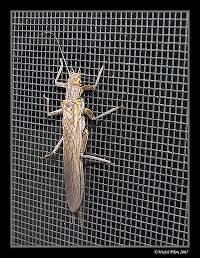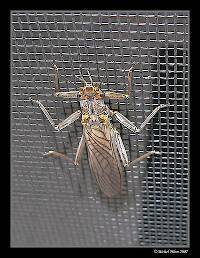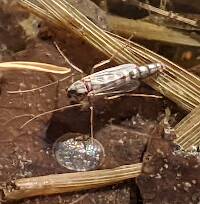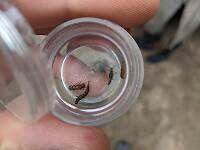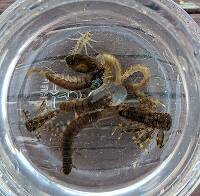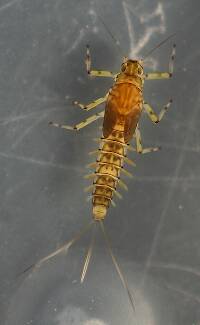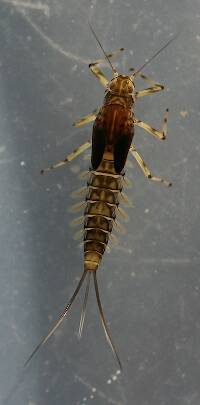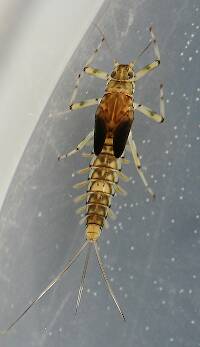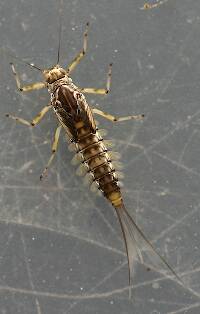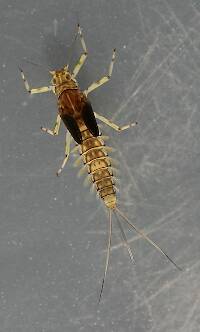
Salmonflies
Pteronarcys californica
The giant Salmonflies of the Western mountains are legendary for their proclivity to elicit consistent dry-fly action and ferocious strikes.
Featured on the forum

This one seems to tentatively key to Holocentropus, although I can't make out the anal spines in Couplet 7 of the Key to Genera of Polycentropodidae Larvae nor the dark bands in Couplet 4 of the Key to Genera of Polycentropodidae Larvae, making me wonder if I went wrong somewhere in keying it out. I don't see where that could have happened, though. It might also be that it's a very immature larva and doesn't possess all the identifying characteristics in the key yet. If Holocentropus is correct, then Holocentropus flavus and Holocentropus interruptus are the two likely possibilities based on range, but I was not able to find a description of their larvae.

Troutnut is a project started in 2003 by salmonid ecologist Jason "Troutnut" Neuswanger to help anglers and
fly tyers unabashedly embrace the entomological side of the sport. Learn more about Troutnut or
support the project for an enhanced experience here.
Wiflyfisher has attached this picture to aid in identification. The message is below.
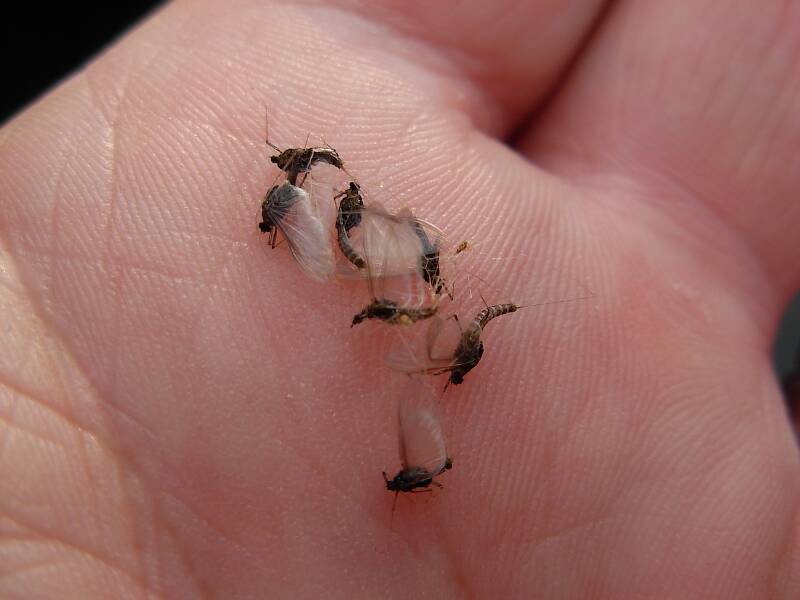
Wiflyfisher on Aug 7, 2007August 7th, 2007, 10:36 am EDT
This morning I had some really small bugs coming off. I was able to grab some off of a spider's web. I know the small blackish guys are Tricos but I am not sure what the little bigger guys are, which was more abundant. Any thoughts?
A #20 pheasant tail dropper with a #20 comparadun did catch several trout. I didn't see enough Tricos to go down to #24's.
A #20 pheasant tail dropper with a #20 comparadun did catch several trout. I didn't see enough Tricos to go down to #24's.
John S.
https://WiFlyFisher.com
https://WiFlyFisher.com
Konchu on Aug 7, 2007August 7th, 2007, 11:02 am EDT
Hard to say. Could be Acentrella.
Wiflyfisher on Aug 7, 2007August 7th, 2007, 11:28 am EDT
Konchu, thanks. I was thinking "Pseudocloeon". Of course, you probably changed that on me too. :-)
John S.
https://WiFlyFisher.com
https://WiFlyFisher.com
Konchu on Aug 7, 2007August 7th, 2007, 1:52 pm EDT
They also could be Plauditus. Most of the Plauditus and Acentrella species were known as Pseudocloeon at one time. I'll bet Taxon has some ideas, too.
And just to be clear, I had NOTHING to do with the Pseudocloeon thing.
And just to be clear, I had NOTHING to do with the Pseudocloeon thing.
Taxon on Aug 7, 2007August 7th, 2007, 7:06 pm EDT
John-
As Konchu suggested, I have some ideas, but would prefer to get some additional information from you before sharing them. I have annotated your photo with two comparable linear dimensions. Please ignore the 1.40", as it was based on photo enlargement.

Anyway, the first dimension is the length of one of the mayfly bodies. The second is the length between two lines on the palm of the hand of the person holding the mayflies. Your assignment, should you choose to accept it, is to measure the "actual" length in mm between the two lines in the palm.
Also, it appears to me that the mayfly I dimensioned has two tails and no hind wings. Can you confirm either of my beliefs from your observation of the actual specimen?
As Konchu suggested, I have some ideas, but would prefer to get some additional information from you before sharing them. I have annotated your photo with two comparable linear dimensions. Please ignore the 1.40", as it was based on photo enlargement.

Anyway, the first dimension is the length of one of the mayfly bodies. The second is the length between two lines on the palm of the hand of the person holding the mayflies. Your assignment, should you choose to accept it, is to measure the "actual" length in mm between the two lines in the palm.
Also, it appears to me that the mayfly I dimensioned has two tails and no hind wings. Can you confirm either of my beliefs from your observation of the actual specimen?
Wiflyfisher on Aug 8, 2007August 8th, 2007, 7:31 am EDT
Twice as long as the Tricos. :-)
I kept them in a flybox but they are all dried up so they are just a mush ball of dead bugs. Besides, I can't see those lines in my hand like that anymore. You should see me trying to thread my 7x tippet through the eyes of those little hooks! Thank goodness for Walmart 2X reading glasses. :)
I kept them in a flybox but they are all dried up so they are just a mush ball of dead bugs. Besides, I can't see those lines in my hand like that anymore. You should see me trying to thread my 7x tippet through the eyes of those little hooks! Thank goodness for Walmart 2X reading glasses. :)
John S.
https://WiFlyFisher.com
https://WiFlyFisher.com
Martinlf on Aug 9, 2007August 9th, 2007, 4:30 am EDT
John, Taxon has used dotted lines, next to the left hand 1.40 to designate the lines he's asking about. They came out faint, but visible when he reposted the photo. If he doesn't darken or enhance them a bit, reading glasses (which I too must use) will make them clearer.
"He spread them a yard and a half. 'And every one that got away is this big.'"
--Fred Chappell
--Fred Chappell
Quick Reply
Related Discussions
Topic
Replies
Last Reply
Re: I need your help to get some specimens of Caecidotea (Freshwater isopods).
In General Discussion by Leonardo
In General Discussion by Leonardo
4
Jun 1, 2016
by Crepuscular
by Crepuscular
24
Jul 21, 2011
by Entoman
by Entoman
2
Apr 20, 2020
by DangerAF1
by DangerAF1

